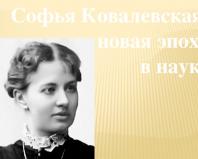Download presentation Spring has come. Presentation on the topic "Spring has come! Spring is coming!" presentation for a lesson on the world around us on the topic
To use presentation previews, create a Google account and log in to it: https://accounts.google.com
Slide captions:
The beauty of spring has arrived!
The sun began to please us and shine more and more. It became warmer.
The forest became lighter and warmer from the sun's rays.
This is a bear's den after winter. The snow melted and she became visible.
A bear walks through the forest in search of food.....
The snow on the rivers and lakes began to turn into ice and began to melt...
The water after winter is dark, cold...
And this brave snowdrop makes its way through the snow, reaching for the sun...
And these brave Snowdrops make their way through the snow, reaching for the sun...
Crayfish have arrived from warmer climes...
The hedgehog woke up after hibernation! Without paths, without roads, a gray ball rolls, it is completely covered in sharp needles, because it is... a hedgehog!
And this is a hedgehog walking with her little hedgehog on the grass...
The trees began to come to life, buds were blooming on the branches...
And on this tree the first green leaves have already appeared from the buds.
The rooks have arrived.
The swallow flies towards us again in the spring.
The starlings flew in, found a birdhouse and settled in it.
And these are also starlings, they are basking in the sun.
A cunning cat is lying down under a birdhouse, pretending to be asleep...
This cat decided to smell what a snowdrop smells like...
Icicles appeared on the roofs, there were a lot of them, which meant spring had come.
That's how huge icicles can be...
On the topic: methodological developments, presentations and notes
Summary of a lesson in artistic creativity (modeling) in the second junior group “Guests have come to us, Dear ones have come…….”
Lesson on artistic creativity in the younger group....
Spring has come - Victory has come!
I propose a script for teaching and educational material for children of the middle and senior groups. Goal: patriotic education. So that everyone lives peacefully, So that everyone sleeps peacefully, Every day and every hour, Oh vigilantly...
Integrated joint activities of a teacher with young children. “Friends came to visit us, it’s time for a treat.”
Fix the names of wild animals; form ideas about their appearance, the quality of fruits and vegetables; activate the words prickly, soft, fluffy, tasty, juicy in children’s speech; bring up...
Slide 2
Today we are going to visit Spring.
And, as has always been the case in Rus', we must glorify the mistress so that she will be kind to us and reveal her secrets to us.
Listen to the poem by E. A. Baratynsky and identify the signs of spring in it.
Spring! Spring! How clean the air is!
How clear is the sky!
Its azuria alive
He blinds my eyes.
Spring! Spring! How high
On the wings of the breeze,
Caressing the sun's rays,
Clouds are flying!
The streams are noisy! The streams are shining!
Roaring, the river carries
On the triumphant ridge
The ice she raised!
The trees are still bare,
But in the grove there is a decaying leaf,
As before under my foot
And noisy and fragrant.
Soared under the sun
And in the bright heights
The invisible lark sings
A cheerful hymn to spring...
Slide 3
What happens in inanimate nature in early spring?
Slide 4
What happens in late spring in inanimate nature?
Slide 5
What types of clouds are there?
Slide 6
What dangers await a person in the mountains?
Slide 7
What happens in spring on reservoirs?
Slide 8
Slide 9
Card: By what changes in nature does Spring announce its arrival?
1. The day with the arrival of spring became:
a) shorter b) longer c) remained the same.
2. The air temperature became:
a) higher b) lower c) has not changed.
3. What natural phenomenon can only be observed in spring?
a) snowfall b) blizzard c) ice drift
1. The days with the arrival of spring have become:
a) colder b) warmer c) remained the same.
2.The vernal equinox falls on:
3.What natural phenomenon can only be observed in spring?
a) blizzard b) snowfall c) flood.
Slide 10
Slide 11
- Why does ice and snow begin to melt in spring?
- In what places does it melt faster?
- How has precipitation changed with the onset of spring?
- How has the soil changed?
- How will nature change further?
Read the proverbs.
- Spring and autumn - there are eight weather conditions per day.
- Don't worry, it's winter, spring will come anyway.
- Spring will give you water, autumn will feed you.
- If you want to eat rolls, don't sit on the stove.
How do you understand their meaning?
Remember what proverbs you know about spring.
Name the spring months.
Slide 12
What changes occur in wildlife in spring?
Slide 13
MARCH - protalnik
Why is this period of spring called so?
If it melts early, it won’t melt for a long time.
If a migratory bird flows in flocks, it means a friendly spring. Long icicles - for a long spring.
Slide 14
April - snowman
April is the month of spring primroses
How a bit of a branch is a guarded dream!
Barely warmed by the ray,
The earrings are in a hurry to give away the smoke,
While the foliage is swaddled.
A. Tvardovsky
A lot of sap flows from the birch - for a rainy summer. The early flight of bees means a red spring. Birds build nests on the sunny side - for a cold summer.
Slide 15
May - grass
May is cold - a grain-bearing year. Late flowering of rowan - for cold autumn. When the bird cherry blossoms, there is always cold.
Slide 16
Early flowering plants.
In spring, representatives of the Plant Kingdom come to life.
Name early flowering plants.
- Snowdrops
- Coltsfoot
- Corydalis
- Lungwort
- Ranunculus anemone
Slide 17
Why were they called that?
- Where do they get the strength for early appearance and flowering? (Nutrient supply.)
- Wind-pollinated plants (willow, alder, poplar, etc.) bloom early. Explain why.
- Then - pollinated by insects. Explain why.
- Find those characteristic features of their structure that determine their early awakening to life.
- Which of these plants did you see, in what places did you meet them?
- Try to explain the origin of their names.
Slide 18
Willow
An early flowering, wind-pollinated tree - willow. It blooms early in the spring, before all other trees have leafed out.
Slide 19
Ash
Light-loving.
Blooms in April-May before the leaves bloom,
It grows quickly on fertile soils, is frost-resistant, and sometimes suffers from late spring frosts. It bears fruit from 25-40 years of age and lives up to 300 years. It spreads by self-sowing and runs wild. The leaf falls in late autumn and is often green.
Slide 20
Migratory birds.
Questions: Changes in inanimate nature and in plant life also affected the life of animals in the spring.
Think about which animals appear earlier in the spring, insects or migratory birds? Why?
Slide 21
What explains the mass arrival of birds in spring? (The presence of a sufficient amount of food: flies, worms and other insects.)
- Which birds return first?
- Talk about their behavior.
- Environmental rules.
- Let's draw up rules for behavior in nature, which will reflect concern for the preservation of early flowering plants and migratory birds.
- Why do people need to care for and protect birds?
- The first harbingers of spring are rooks. It is important that they walk through the first thawed patches. March 17 is considered Rook. At this time these birds begin to arrive. Starlings and larks will fly after the rooks. On March 21, according to the old custom, buns with raisin eyes were baked, which were called “larks.”
Slide 22
Here are some examples of the number of insects that birds eat themselves and bring to their chicks. The great tit destroys up to 6,000 insects during the day, rooks destroy up to 8,000 harmful worms and caterpillars. A swallow catches up to 1,000,000 midges and mosquitoes over the summer. Thus, birds protect crops and plantings and bring great benefits to humans.
Slide 23
Why is spring the time of awakening of nature?
Slide 1
Slide 2
 http://viki.rdf.ru/item/337/"Spring" by A. Vivaldi (music video) design by E. Beryukhova.
http://viki.rdf.ru/item/337/"Spring" by A. Vivaldi (music video) design by E. Beryukhova.
Slide 3
 I. Levitan. “March” I. Levitan. "Spring. Big water." A. Savrasov. “The Rooks have Arrived” The artists reflected spring in all its diversity in their works. Here, the approach of spring, when there is still snow, the trees are bare, but the breath of spring is felt in everything: in the sunlight, swollen buds, darkening and settling snow; in the hubbub of rooks; in river floods.
I. Levitan. “March” I. Levitan. "Spring. Big water." A. Savrasov. “The Rooks have Arrived” The artists reflected spring in all its diversity in their works. Here, the approach of spring, when there is still snow, the trees are bare, but the breath of spring is felt in everything: in the sunlight, swollen buds, darkening and settling snow; in the hubbub of rooks; in river floods.
Slide 4
 I. Tokmakova SPRING. Spring is coming towards us with quick steps, and the snowdrifts are melting under her feet. Black thawed patches are visible in the fields. That's right, spring has very warm feet.
I. Tokmakova SPRING. Spring is coming towards us with quick steps, and the snowdrifts are melting under her feet. Black thawed patches are visible in the fields. That's right, spring has very warm feet.
Slide 5
 Fyodor Tyutchev Winter is angry for a reason, Its time has passed - Spring is knocking on the window And driving it out of the yard. And everything began to fuss, Everything forced Winter out - And the larks in the sky Already started ringing the bell. Winter is still busy and grumbling about Spring. She laughs in her eyes And only makes more noise... The evil witch went mad And, grabbing the snow, She let it run away into the beautiful child. Spring and grief are not enough: I washed my face in the snow, And only became blusher, In defiance of the enemy. No wonder winter is angry
Fyodor Tyutchev Winter is angry for a reason, Its time has passed - Spring is knocking on the window And driving it out of the yard. And everything began to fuss, Everything forced Winter out - And the larks in the sky Already started ringing the bell. Winter is still busy and grumbling about Spring. She laughs in her eyes And only makes more noise... The evil witch went mad And, grabbing the snow, She let it run away into the beautiful child. Spring and grief are not enough: I washed my face in the snow, And only became blusher, In defiance of the enemy. No wonder winter is angry
Slide 6
 “Spring Waters”, “Spring Thunderstorm” F. I. Tyutchev - What picture does F. I. Tyutchev paint for us? - What mood do certain events evoke in the narrator?
“Spring Waters”, “Spring Thunderstorm” F. I. Tyutchev - What picture does F. I. Tyutchev paint for us? - What mood do certain events evoke in the narrator?
Slide 7

Slide 8
 What kind of spring did Alina see? Everything: music, dance are imbued with optimism, lightness, and soaring emotions. Spring is bright, cheerful, fast; gentle and bright, quiet and smiling. http://www.muzoff.ru/pages/414/41460.shtml
What kind of spring did Alina see? Everything: music, dance are imbued with optimism, lightness, and soaring emotions. Spring is bright, cheerful, fast; gentle and bright, quiet and smiling. http://www.muzoff.ru/pages/414/41460.shtml
Slide 9
 The fragrant bird cherry blossomed in spring and the golden branches curled like curls. All around, honey dew Slides down the bark, Beneath it, spicy greenery Shines in silver. And nearby, by the thawed patch, in the grass, between the roots, a small Silver stream runs and flows. The fragrant bird cherry stands hanging, and the golden greenery burns in the sun. The stream pours over all the branches like a thunderous wave, and insinuatingly sings songs to it under the steep slope. Sergey Yesenin CHERYOMUKHA
The fragrant bird cherry blossomed in spring and the golden branches curled like curls. All around, honey dew Slides down the bark, Beneath it, spicy greenery Shines in silver. And nearby, by the thawed patch, in the grass, between the roots, a small Silver stream runs and flows. The fragrant bird cherry stands hanging, and the golden greenery burns in the sun. The stream pours over all the branches like a thunderous wave, and insinuatingly sings songs to it under the steep slope. Sergey Yesenin CHERYOMUKHA
Slide 10
 Alexey Pleshcheev The snow is already melting, streams are running, Spring is blowing through the window... The nightingales will soon whistle, And the forest will be dressed in leaves! The blue of the sky is pure, the sun has become warmer and brighter, the time for evil blizzards and storms has passed for a long time again... ***
Alexey Pleshcheev The snow is already melting, streams are running, Spring is blowing through the window... The nightingales will soon whistle, And the forest will be dressed in leaves! The blue of the sky is pure, the sun has become warmer and brighter, the time for evil blizzards and storms has passed for a long time again... ***
Slide 11
 Alexey Pleshcheev The grass is green, the sun is shining; A swallow flies towards us in the canopy with spring. With her the sun is more beautiful And spring is sweeter... Chirp from the road Greetings to us soon! I will give you some grains, and you sing a song that you brought with you from distant lands... ***
Alexey Pleshcheev The grass is green, the sun is shining; A swallow flies towards us in the canopy with spring. With her the sun is more beautiful And spring is sweeter... Chirp from the road Greetings to us soon! I will give you some grains, and you sing a song that you brought with you from distant lands... ***
Slide 12
 Samuel Marshak April! April! Drops are ringing in the yard. Streams run through the fields, There are puddles on the roads. The ants will soon come out after the winter cold. A bear makes his way through the thick dead wood. The birds began to sing songs and the snowdrop blossomed.
Samuel Marshak April! April! Drops are ringing in the yard. Streams run through the fields, There are puddles on the roads. The ants will soon come out after the winter cold. A bear makes his way through the thick dead wood. The birds began to sing songs and the snowdrop blossomed.
Slide 13
 Independent work (check) Irina Tokmakova “Spring” F. I. Tyutchev “Spring waters”, “Spring thunderstorm” “Winter is angry for good reason” Sergey Yesenin “Cheryomukha” Alexey Pleshcheev “The grass is turning green”, “The snow is already melting, the streams are running” Samuel Marshak “April!” April!" summary of other presentations
Independent work (check) Irina Tokmakova “Spring” F. I. Tyutchev “Spring waters”, “Spring thunderstorm” “Winter is angry for good reason” Sergey Yesenin “Cheryomukha” Alexey Pleshcheev “The grass is turning green”, “The snow is already melting, the streams are running” Samuel Marshak “April!” April!" summary of other presentations “Integrated lesson on the world around us”- Ravine. Compass. Pacific Ocean. Kerosene. How is the word "tundra" translated? What is the support of the human body. The amount of information about the surrounding world. How many muscles are there in the human body? The main property of the soil. The lowest part of the mountain. Boundary of visible space. Tasks that stimulate cognitive interest. Ancient geographical maps. Mountains. Properties of coal. What is humidity? The world.
"Stones"- The wind carries plant seeds into the cracks of the rocks. Tufts of herbs, bushes and even trees grow in the stones. In nature, on warm days, stones and rocks heat up. Water gets into the cracks. The water rolls over the pebbles, grinds them, crushes them and gradually turns them into sand and clay. And at night they cool down. How are rocks destroyed?
"Benelux"- Belgium. Luxembourg. Country of bicycles. Entrance to the zoo. Brussels. One of the smallest countries in the world? Coat of arms and flag. Tulip fields. Which countries make up the Benelux? Square in Luxembourg. Benelux countries. The capital is Amsterdam. Netherlands (Holland). Flag and coat of arms. Country of tulips. The Netherlands is a country of canals. The world's only floating flower market. The flower is a symbol of the Netherlands. There are many ancient windmills in Holland.
"Diversity of Nature"- Work in groups. Kingdoms. Creative work in pairs. Kingdom of bacteria. Kingdom of mushrooms. Live nature. The meaning of nature for me. Nature. Inanimate nature. Give an example. Animal Kingdom. Diversity of nature.
"Castles of France"- Castles of France. Mont Saint Michel. Cathedral of Our Lady of Poriga. Creepy chimeras. Bargem Castle. Palaces and castles. Castle of Chaumont-sur-Loire. Palace of Versailles. Chambord Castle. Castle If. Amboise Castle. Chenonceau Castle.
"The Moon is a natural satellite"- Moves around the Earth. A lunar eclipse lasts no more than 1 hour. The bright Sun disappears for a few minutes. The surface of the Moon is covered with craters. The Moon is the closest neighbor of the Earth in Space. In July 1969, man first set foot on the surface of the Moon. Only one side of the Moon always faces our planet. The moon has been subject to intense research. Surface of the Moon. During the full moon, the entire surface of the Moon is illuminated.




